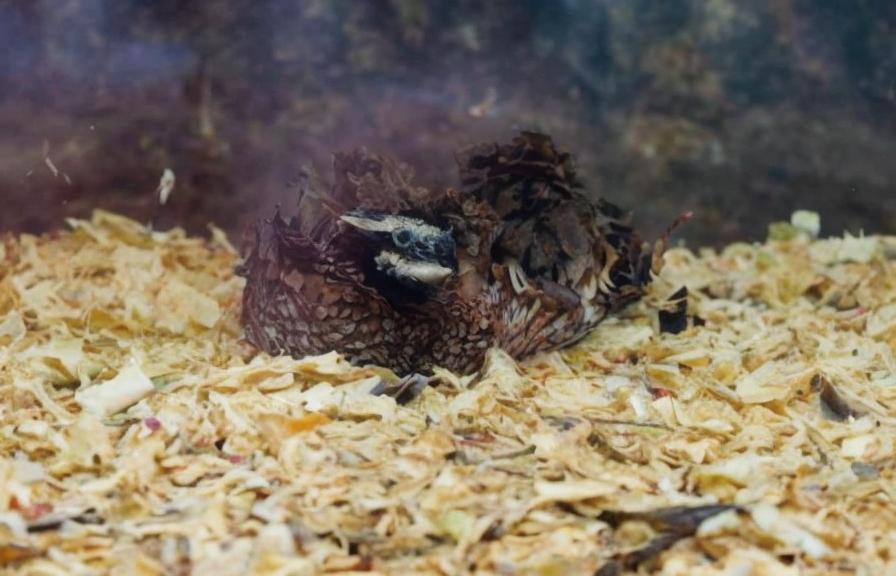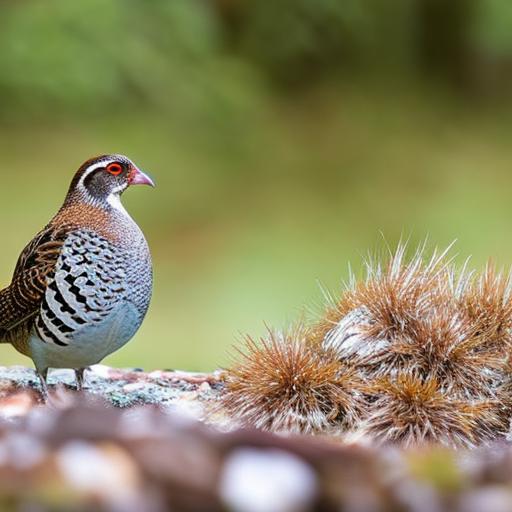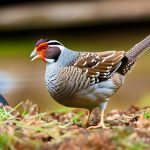Japanese quail, also known as Coturnix quail, are small birds that are native to East Asia. They are popular among poultry enthusiasts for their small size, easy care, and prolific egg-laying abilities. Japanese quail are often raised for their eggs and meat, and they are also kept as pets. These birds are known for their gentle nature and are relatively easy to handle, making them a great choice for beginners or those with limited space. Japanese quail come in a variety of colors, including brown, white, and speckled, and they are known for their distinctive call, which sounds like “bob-white.”
Japanese quail are hardy birds that can adapt to a wide range of climates, making them suitable for both indoor and outdoor housing. They are social animals and should be kept in groups of at least three to five birds to prevent loneliness and stress. These birds are also known for their high egg production, with each hen laying up to 300 eggs per year. Japanese quail eggs are smaller than chicken eggs but are prized for their rich flavor and high nutritional value. In addition to their egg-laying abilities, Japanese quail are also raised for their meat, which is lean and flavorful. Overall, Japanese quail are a versatile and low-maintenance option for poultry enthusiasts and can be a valuable addition to a small farm or homestead.
Key Takeaways
- Japanese quail are small, hardy birds that are popular for their eggs and meat production.
- They require a well-ventilated and spacious enclosure with proper flooring and lighting.
- A balanced diet with a mix of commercial feed, greens, and protein sources is essential for their health and productivity.
- Breeding Japanese quail requires careful management of nesting areas and monitoring of egg production.
- Regular health checks, vaccination, and proper sanitation are crucial for preventing diseases in quail.
Housing and Enclosure Requirements
When it comes to housing Japanese quail, there are a few key considerations to keep in mind. Firstly, the enclosure should provide enough space for the birds to move around comfortably and engage in natural behaviors such as dust bathing and foraging. A good rule of thumb is to provide at least 1 square foot of space per bird. The enclosure should also be secure and predator-proof, as quail are vulnerable to attacks from predators such as cats, dogs, and birds of prey. Additionally, the enclosure should have good ventilation to prevent the buildup of ammonia from droppings and to maintain a healthy environment for the birds.
Japanese quail can be housed in a variety of setups, including cages, aviaries, or coops. If keeping quail indoors, it’s important to provide a substrate such as wood shavings or sand for dust bathing and to absorb droppings. Outdoor enclosures should have a covered area to protect the birds from the elements and provide shade during hot weather. It’s also important to provide hiding spots and perches for the quail to roost on. Overall, the key to successful housing for Japanese quail is to provide a safe, comfortable, and enriching environment that meets their physical and behavioral needs.
Feeding and Nutrition
Proper nutrition is essential for the health and well-being of Japanese quail. A balanced diet will not only support their overall health but also contribute to their egg production and meat quality. A commercial quail feed is a convenient option that provides all the essential nutrients in the right proportions. Look for a feed specifically formulated for quail that contains a high percentage of protein (around 20-25%) to support their rapid growth and egg production. Additionally, providing access to grit or crushed oyster shells will help with digestion and provide essential calcium for eggshell formation.
In addition to commercial feed, Japanese quail can also benefit from a variety of fresh foods such as leafy greens, fruits, and vegetables. These can be offered as treats or supplements to their diet. It’s important to avoid feeding them foods that are toxic to birds, such as avocado, chocolate, and caffeine. Fresh water should always be available, either through a gravity-fed waterer or shallow dish. It’s important to monitor the water source regularly to ensure it is clean and free from contaminants. Overall, providing a balanced diet with access to fresh water is essential for the health and productivity of Japanese quail.
Breeding and Reproduction
Breeding Japanese quail can be a rewarding experience for poultry enthusiasts. These birds reach sexual maturity at around 6-8 weeks of age, making them prolific breeders. When breeding quail, it’s important to provide a suitable nesting area with soft bedding material such as straw or shredded paper. The nesting area should be secluded and provide privacy for the hens to lay their eggs. It’s also important to monitor the ratio of males to females in the breeding group to prevent aggression and overbreeding.
Japanese quail are known for their high egg production, with each hen laying up to 300 eggs per year. The eggs are small but packed with nutrients and have a rich flavor. The incubation period for quail eggs is relatively short, lasting around 17-18 days. If breeding quail for eggs or meat production, it’s important to have an incubator on hand to hatch the eggs. Once hatched, the chicks should be provided with a warm brooder area and access to chick starter feed. Proper care and attention during the breeding process will ensure healthy offspring and a successful breeding program.
Health and Disease Management
Maintaining the health of Japanese quail is essential for their well-being and productivity. Regular health checks should be conducted to monitor for signs of illness or injury. Common health issues in quail include respiratory infections, parasites, and nutritional deficiencies. It’s important to quarantine any sick birds to prevent the spread of disease within the flock. Additionally, providing a clean environment with good ventilation and proper sanitation practices will help prevent the onset of disease.
Preventative measures such as vaccination and parasite control should be implemented as recommended by a poultry veterinarian. It’s also important to provide a balanced diet with access to clean water to support their immune system. Regular cleaning of the enclosure and nesting areas will help prevent the buildup of bacteria and parasites. Overall, proactive management of their health through regular monitoring, preventative measures, and prompt treatment of any issues will help ensure the long-term health and productivity of Japanese quail.
Handling and Care

Japanese quail are generally docile birds that can be easily handled with proper care and attention. When handling quail, it’s important to approach them calmly and gently to avoid causing stress or injury. It’s best to handle them from a young age to acclimate them to human interaction. When picking up a quail, it’s important to support their body with both hands to prevent injury or struggling.
Regular handling can help tame quail and make them more comfortable with human interaction. It’s important to provide enriching activities such as dust baths, perches, and hiding spots to keep them mentally stimulated and prevent boredom. Additionally, providing opportunities for social interaction within the flock will help prevent loneliness and stress. Overall, gentle handling and providing enriching care will help ensure the well-being and contentment of Japanese quail.
Legal Considerations and Regulations
Before embarking on raising Japanese quail, it’s important to be aware of any legal considerations and regulations that may apply in your area. Some regions may have specific regulations regarding the keeping of poultry, including zoning restrictions, permits, or biosecurity measures. It’s important to research local laws and regulations before starting a quail-raising operation.
Additionally, it’s important to consider ethical considerations such as animal welfare standards when raising quail. Providing a safe and enriching environment that meets their physical and behavioral needs is essential for their well-being. It’s also important to source quail from reputable breeders or hatcheries that prioritize animal welfare and ethical breeding practices.
In conclusion, raising Japanese quail can be a rewarding endeavor for poultry enthusiasts. These small birds are known for their prolific egg-laying abilities, gentle nature, and low maintenance requirements. By providing proper housing, nutrition, care, and attention to their health needs, Japanese quail can thrive in a variety of settings from small backyard flocks to larger commercial operations. It’s important to be aware of legal considerations and regulations that may apply in your area before starting a quail-raising operation. With proper planning and management, Japanese quail can be a valuable addition to any poultry enthusiast’s flock.
If you’re interested in keeping Japanese quail, you may also want to explore the benefits of raising chickens. Poultry Wizard offers a helpful article on creating a chicken coop in Grand Island, NE, which provides valuable insights into housing and caring for chickens. Check out the article here to learn more about creating a comfortable and functional living space for your feathered friends.
FAQs
What are Japanese quail?
Japanese quail, also known as Coturnix japonica, are small ground-dwelling birds that are commonly kept for their eggs and meat. They are native to East Asia and are popular for their fast growth and high egg production.
What do Japanese quail eat?
Japanese quail are omnivorous and their diet consists of a variety of foods including seeds, grains, insects, and small invertebrates. They can be fed a commercial quail feed or a mixture of grains and seeds.
How do you keep Japanese quail?
Japanese quail can be kept in cages or aviaries with proper ventilation and protection from predators. They require a clean and dry environment with access to food and water at all times. It’s important to provide them with a balanced diet and regular health checks.
How do you care for Japanese quail chicks?
Japanese quail chicks require a warm and draft-free brooder with access to food and water. They should be provided with a high-protein starter feed and monitored closely for any signs of illness or distress.
What are the benefits of keeping Japanese quail?
Keeping Japanese quail can provide a sustainable source of eggs and meat for personal consumption or for sale. They are relatively easy to care for and can be a profitable addition to a small farm or homestead.
Meet Walter, the feathered-friend fanatic of Florida! Nestled in the sunshine state, Walter struts through life with his feathered companions, clucking his way to happiness. With a coop that’s fancier than a five-star hotel, he’s the Don Juan of the chicken world. When he’s not teaching his hens to do the cha-cha, you’ll find him in a heated debate with his prized rooster, Sir Clucks-a-Lot. Walter’s poultry passion is no yolk; he’s the sunny-side-up guy you never knew you needed in your flock of friends!







